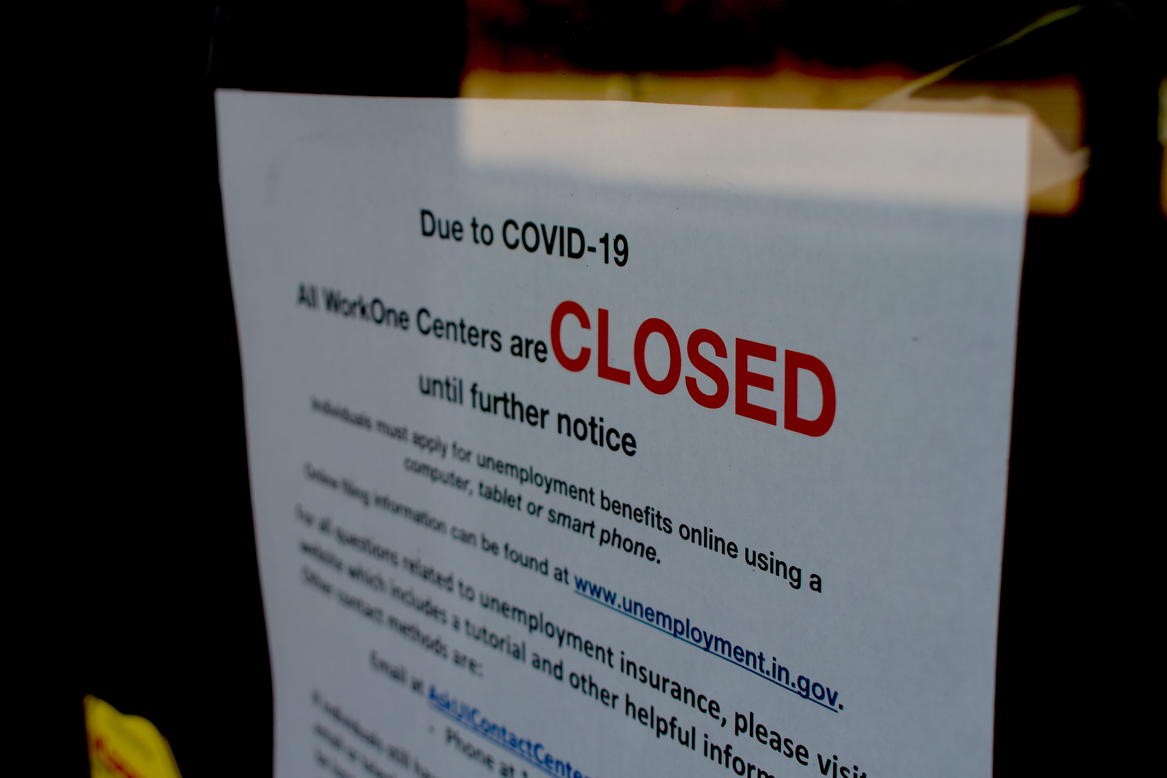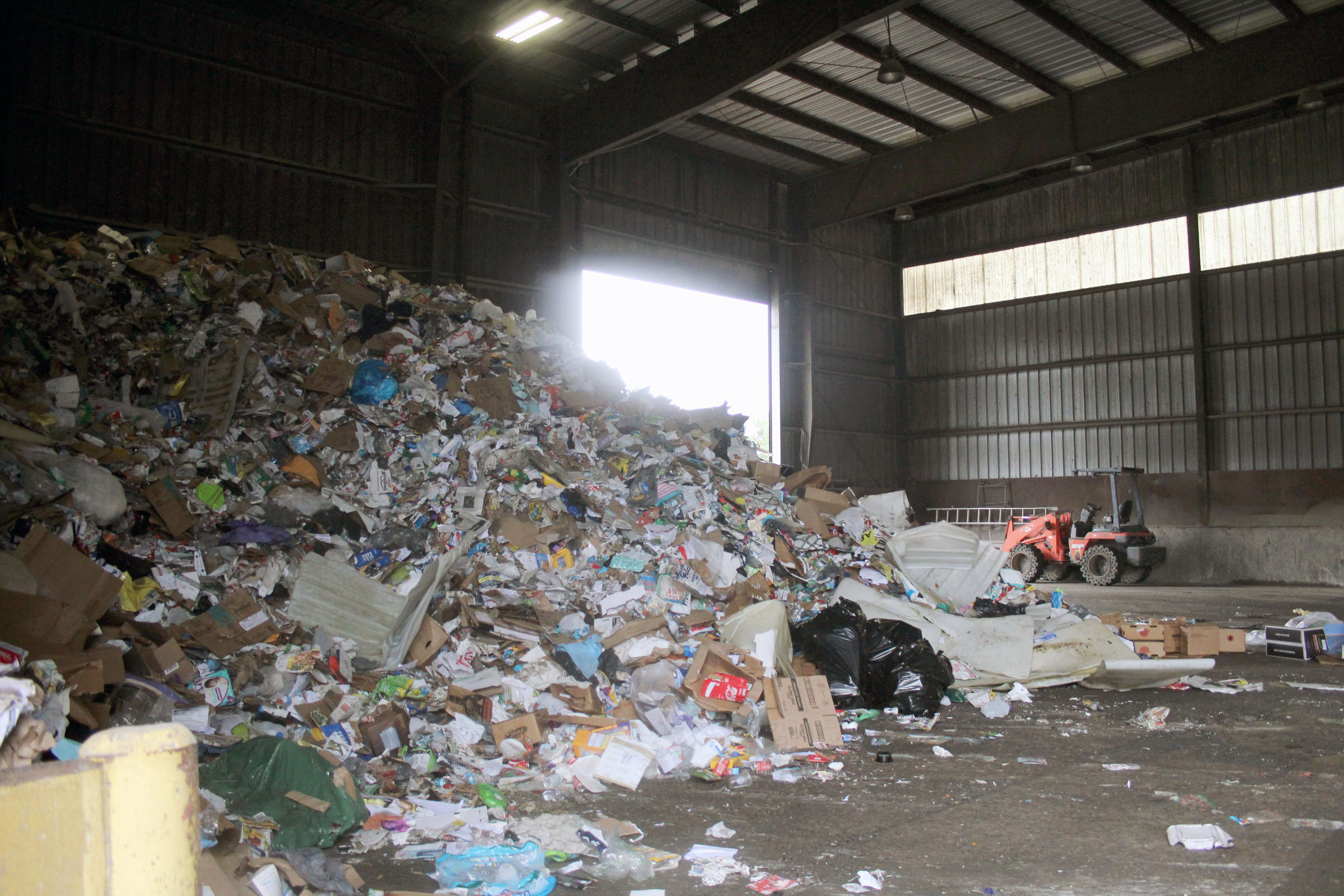
In Tippecanoe County, curbside recycling is taken to a transfer station on the north side of Lafayette. Curbside pickup is dumped inside the warehouse. (Taylor Haggerty/WBAA News)
After West Lafayette’s recycling drop-off center closed earlier this year, local officials struggled to find a way to meet demand from residents. The closure coincided with a nationwide upheaval as China stopped accepting materials from the United States.
China’s decision has had far-reaching effects, with major recycling centers closing or halting operation in multiple states.
Despite being a landlocked state that didn’t do much work with China, Indiana has also felt the impact. China’s decision has created a glut in the market – so even if facilities process materials, they may not have any buyers.
“No commodity put in a recycling bin was untouched by that oversupply that then caused the value of those materials to plummet,” says Allyson Mitchell, executive director of Indiana Recycling Coalition.
Mitchell says the recycling sent to material recovery facilities – businesses responsible for sorting and selling product – are often contaminated, and can’t be processed.
“As a country, and probably as a global society, we got pretty lazy about enforcing what to put in the bin and, even more importantly, what not to put in the bin,” Mitchell says.
And in Indiana, that lack of recycling education is hurting the entire industry.
Tippecanoe County’s recycling program will cost the county $70,000 next year, according to county commissioner Tom Murtaugh, in part because the materials being processed and sold aren’t worth enough to cover operation costs.
“We’re hopefully going to receive a little bit of revenue back, but it will nowhere, in no way offset the cost of actually running the recycle program,” Murtaugh says.
Following the West Lafayette closure, residents not enrolled in city curbside pickup plans must go to a site on Lafayette’s north side if they want to recycle, or travel to satellite pickup stations.
“When we compare numbers, there hasn’t been a drop-off in the amount that they’ve been seeing,” Murtaugh says. “So we’re very excited about the fact that people have not stopped recycling.”
Even so, the shift has caused some problems. The satellite locations have a high contamination rate, with some residents dumping items like plastic sheds.
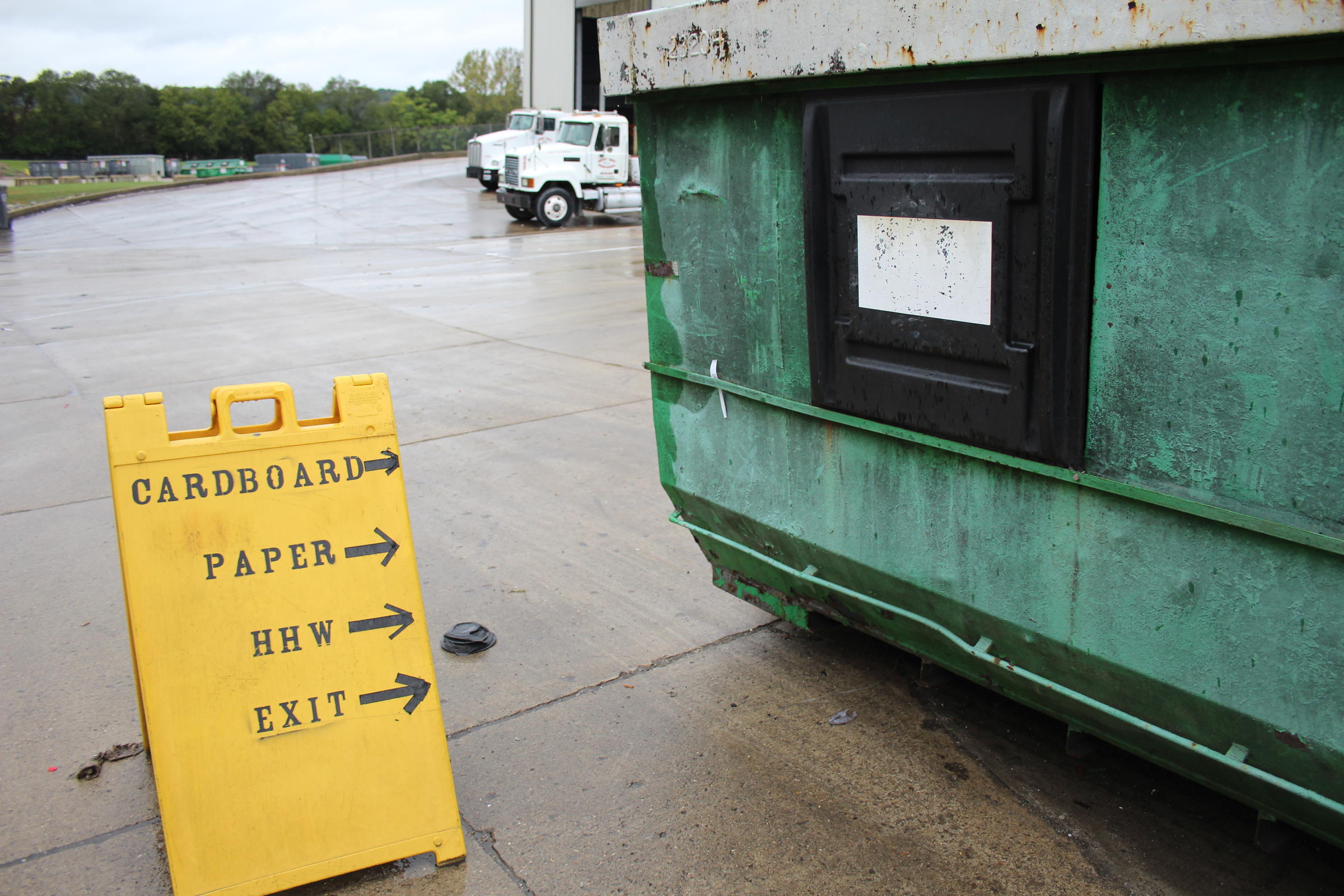
The county passed an ordinance fining anyone dumping unsanctioned materials at the drop-off centers. But county recycling coordinator Amy Krzton-Presson says it may not be clear what’s allowable.
“It’s a learning curve on figuring out what’s the right way to recycle,” Krzton-Presson says. “We can’t just throw everything in the bin and hope somebody figures it out. We have to figure it out from here.”
Krzton-Presson says residents tend to make assumptions – often relying on the numbers printed on plastics. She says officials could make it clearer still.
“Saying bottles and jugs, that really limits what people are going to think about,” Krzton-Presson says. “They’re not going to try and put a plastic toy in there, that’s not a bottle or a jug.”
Those guidelines will be communicated through signs and labels at the drop-off centers. But while signs are in place at the rural sites, they haven’t been constructed at the North Ninth Street facility.
Inside the warehouse, a mountain of mixed recycling brought in from the curbside program sits in a pile, waiting to be compacted and transported to a materials recovery facility, rather than sorted onsite. The onsite bins are confusing, too – most of them not labelled.
And while the program does accept glass, officials say mixing glass with the rest of the bins can result in contamination and makes it harder to process everything. Even so, there’s no separate receptacle for glass products.
Krzton-Presson says a group of Purdue University students is planning to analyze the contents of the recycling bins in coming months to better understand what contaminants are being left behind. From there, the county will work to address misinformation and clearly communicate what’s allowed.
West Lafayette Street Supervisor Ben Anderson works at the former site of the West Lafayette drop-off. He says they did a lot of what the county hopes to do – clear signage, separate bins. But no amount of instruction kept people from disposing of their materials improperly.
“As many signs as we had out there, all the stuff that the county’s dealing with, it doesn’t surprise us,” Anderson says. “We’ve had car parts, in the aluminum cans we would have aluminum containers.”
He says the city pushed to educate residents and implement a recycling program between 2010 and 2013. But since then, they’ve lapsed in communicating what can be accepted.
“What have we really done to continue to educate about recycling? Have we really done much besides follow what we hear in the news? Probably not,” he says.
Lafayette officials are also seeking ways to clarify the state of the city’s curbside recycling program. A flyer was sent to some residents earlier this month detailing what could be accepted. But that flyer caused confusion for residents, as it conflicted with previous guidelines and even the information on the city's website.
Mayor Tony Roswarski says says while the flyer did have some accurate information, telling residents not to recycle light bulbs or food-soiled paper, there were some inaccuracies.
“There were other items on there that we do recycle and that we will continue to recycle, according to the contract I’ve looked at, our part of the contract that we have with the company,” Roswarski says. “I do have a call in to the county attorney to make sure that we’re interpreting the contract the same way.”
The flyer says the program won’t be accepting glass, for example, but Roswarski says that’s not the case.
“It was confusing, and I apologize for that, but there’s no changes to our recycling program, and I don’t see any changes coming,” he says.
Roswarski says they plan to keep the recycling program free for residents. He says the primary change is in the messaging. Previous communications from the city had included lines like “When in doubt, toss it in the bin!” – something Roswarski says isn’t the proper way to approach recycling anymore.
“There was a time in the recycling world where that was fine, but the recycling world has changed considerably,” Roswarski says. “So now we’ve changed that to: ‘Only recycling in the bins please.’”
He says the priority right now is ensuring that whatever recycling does make it into residents’ bins is clean enough to be processed.
According to The Recycling Partnership’s Senior Director of Strategy & Research, Scott Muow, officials need to directly engage with residents to eliminate contamination, and the decision to start recycling has to be community-wide.
“Everybody has to decide at that community level whether they want to do curbside recycling, whether they want to take on the costs of that program, and how to do it,” he says.
The cost of a program will vary. Depending on what a city needs, collection trucks can cost between $80,000 and $280,000 a piece, plus additional maintenance and employees to man it.
“You’ve got two parts of that equation: the cost itself, which goes back to how efficient the service is and what kind of equipment, what kind of staffing is being deployed, and then the tons itself,” Muow says. “How much are you collecting against those costs?”
Muow says, even if a truck collects a few tons of material a day, the processing costs of those materials will go up in accordance with the contamination levels.
“When a curbside program is in operation, and it finds that it has 20 percent or more contamination, it’s going to have a very high cost per ton in the MRF processing, so it’s really critical to address that,” he says.
He says there are different ways to address the issue. In one case, a town in Ohio tagged every contaminated recycling bin. The tagged bins were left behind, while clean bins were collected.
“If you engage them and provide them really clear and consistent information, you can have contamination rates in a cart at less than 10 percent,” he says.
Muow says the financial burden isn’t a reason to stop recycling. He says communities need to see it as a public service, just like trash collection.
“Garbage doesn’t pay for itself either,” Muow says. “When you put garbage into a garbage truck and take it to a landfill, no one is paying you to put that garbage there. You get charged to put that garbage into a landfill or incinerator.”
And Indiana Recycling Coalition’s Allyson Mitchell says, if Indiana can come to view recycling as an opportunity instead of a financial burden, it can bring investment and growth into the state.
“When we have a robust recycling program on par with other states, we can compete on a broader quality-of-life standpoint,” Mitchell says.
The Indiana Department of Environmental Management has approved a study to analyze the industry’s strengths and weaknesses.
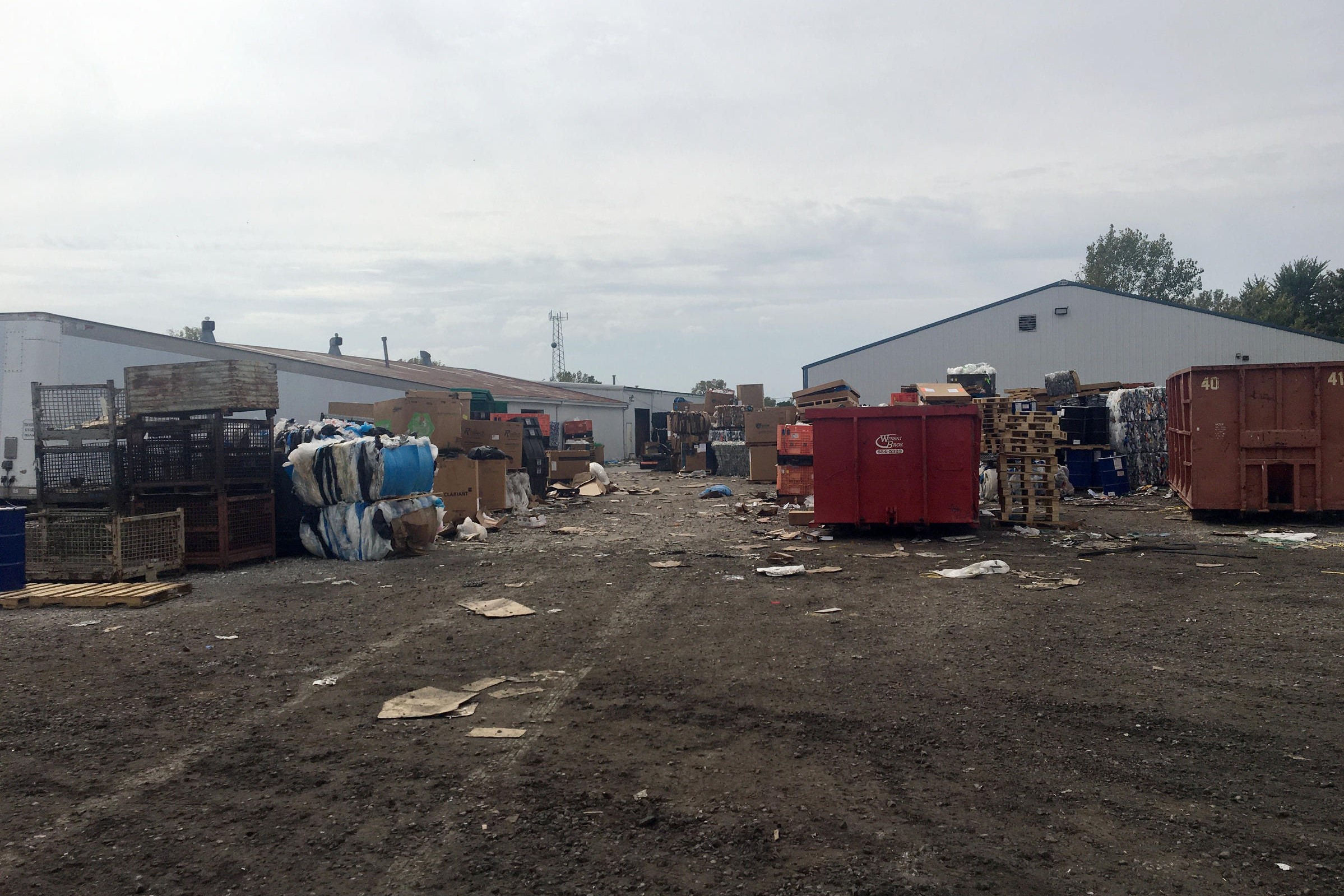
Barriers To Development And Expansion
Recycling programs often rely on a few major players, rather than a competitive market. Industry leaders are searching for ways to make it economically sustainable in a changing landscape, both for cities and for manufacturers. But even when a system is working, there’s no guarantee it will last.
A fire tore through Frankfort’s Werner & Son recycling plant earlier this year. The disaster has had long-lasting effects: since July, the city’s street department has handled local residential recycling, collecting materials on a monthly basis instead of weekly, and nearby towns including Delphi and Flora that also relied on Werner have suspended their curbside pickup.
Company President Troy Werner says he’s not sure where else they’d go. There is another recycling plant in town, but they only handle cardboard and paper – meaning any customers trying to recycle plastic found themselves without an option.
“Called my customers, the first thing they asked was, ‘Do you have a competitor you can recommend?’ And I said, ‘I’m sorry, but I don’t. To do what we do, and provide the same services that we do, no,’” Werner says.
Werner is rebuilding his business, but says it’ll still be some time before they can handle the amount of product they were taking in before. He’s purchased all of the equipment they need to get up and running, but until they can complete construction of a new building, there’s nowhere to put it. And even when it’s at full scale, the profits will still be small.
“It just takes a while to build,” he says. “We were 28 years on that location.”
While Werner says he can usually find buyers for paper, plastics can be more difficult. Some materials are worth just a penny and a half per pound.
And there’s another barrier: equipment costs. Werner says the machinery they need is often made to order. The new facility has just one baler right now to bundle up products like plastic and cardboard. He says they bought it used, for roughly $150,000.
“If you were to start from scratch right now, starting, no expenses, no income, and decide you want to get into the recycle business, it wouldn’t take you very long to figure out, I can’t spend $4 million and sort stuff that’s worth $30 a ton,” he says.
Werner says residential recycling is just a small portion of what they do; the company also manages properties in the area, and most of their product comes from nearby industrial plants.
“If we were doing just residential single-stream, we would be doing something else,” he says. “There’s not enough money to be doing that right now.”
Industrial co-mingle comes to the facility mostly sorted out. Werner receives trucks full of identical items, made of the same plastics or metals, that require less labor to process. But residential product is messier and takes more time.
“Come up on the belt, watch it go by,” Werner says. “And every person that I’ve had come in, shocked. Shocked at what they see.”
Bags of residential recycling often contain items like diapers, full bottles of soda, and food waste. None of the items can be processed at the plant, and they often end up contaminating what Werner can accept.
“We’re careful not to say the word ‘waste’ in some regards. Because it’s only waste if we perceive it to be waste,” says Abigail Engelberth, Purdue University professor of Environmental & Ecological Engineering.
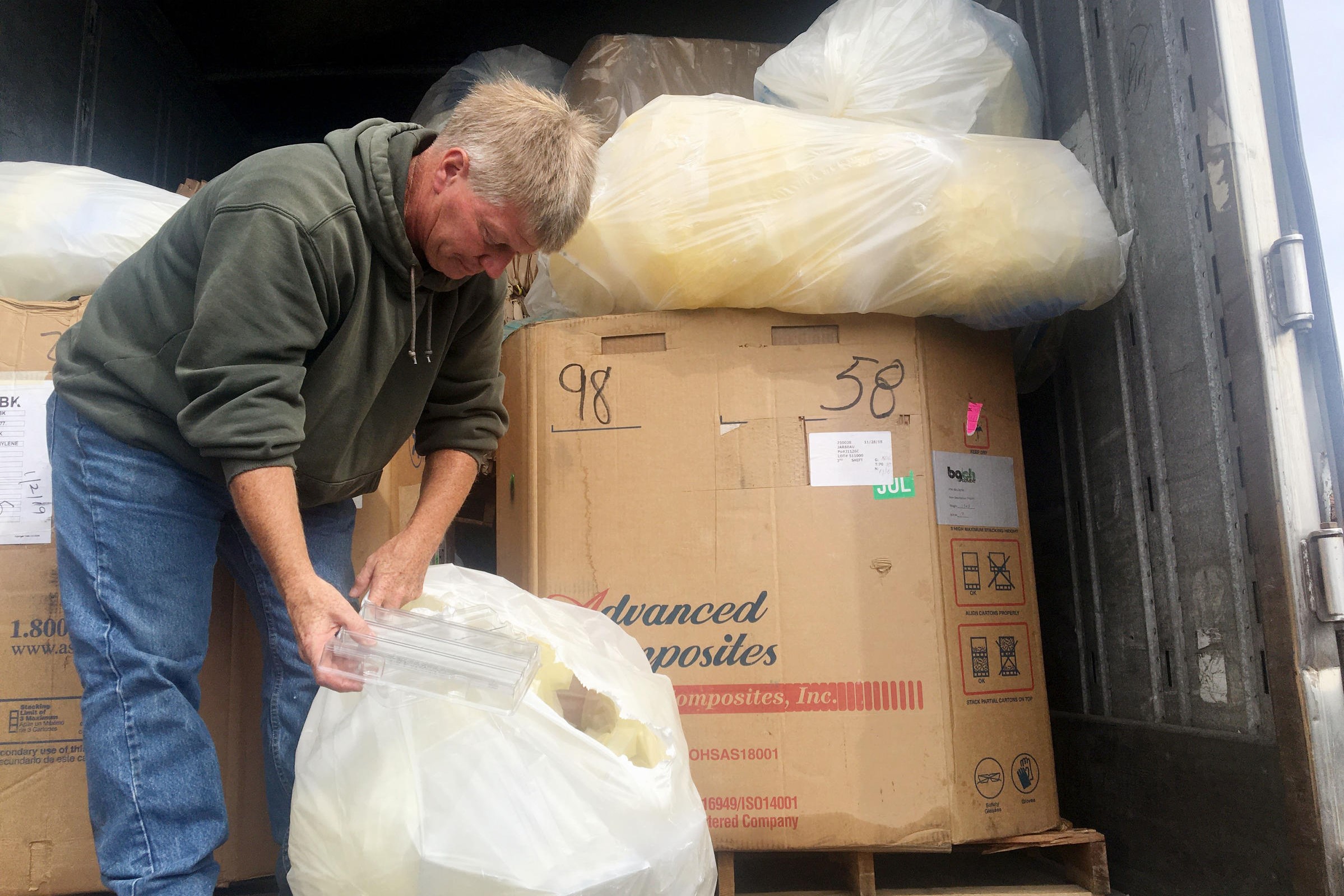
Engelberth says there are a number of hurdles in the way to reaching economic sustainability in the industry.
“Transportation, logistics, cleanliness, lack of sorting and then things get put in that clog up the system,” she says.
Engelberth says some of the expenses can be eliminated, if residents are willing to do a little extra work at home.
“One of the high costs is because nothing is sorted, so now we’re paying to have it sorted. Right? So now we’re paying to have it sorted, whereas the resident could easily do that type of thing,” she says.
And Purdue Environmental & Ecological Engineering Department Head John Sutherland says mixing materials results in more contamination – either from single-stream collection, or because manufacturers are making items that involve multiple materials, like a plastic bottle with a sticky paper label.
“It’s easy if you have a pure material to recycle, but you know, we don’t often make things of pure materials, and then we get them contaminated,” he says.
And, Sutherland says, the low return on investments comes in part from a lack of demand; things made from recycled products can be seen as lower quality, so not every manufacturer is interested in recycled material.
“Unless there is a demand for products with recycled content, there is never then the demand, to create that pull that helps to make the recycling process work,” Sutherland says.
Engelberth says a shift could come from societal pressure for longer-lasting or recyclable goods.
“I would say pressure manufacturers,” she says. “That would be easier, and that’s where the change is going to happen.”
But Indiana University Professor Shahzeen Attari says when it comes to consumer pressures, movements in the public eye right now tend to focus on smaller issues with minimal impact.
“I think that there have been many cases where social pressure causes huge changes that may or may not be the most effective thing to change,” Attari says. “The most recent example is many cities enacting the straw ban.”
Attari says the methods easiest to accomplish are those everyone was raised to do: turn off the lights when leaving a room and recycle plastics.
“People have been taught ever since they were young to do these actions,” Attari says. “So their internal belief system is very tightly wound to being an environmentalist and actually acting out these actions.”
And sometimes, Attari says, social pressure does result in a change on an individual level.
“If you tell me that I use a lot more energy than my neighbors, that actually leads to my decreasing my energy use.”
But those behaviors don’t eliminate contamination or even broader issues of sustainability, like reducing carbon dioxide emissions or plastics production.
“The thing is we need to think about how to leverage individual behavior change and individual action into collective action, and then into policy,” Attari says.
Attari says pushing for policy change is what will bring manufacturers and consumers to more sustainable practices.
But it’s difficult to know what those sustainable practices will look like.
Engelberth says systems that offer deposits for properly recycled materials, like bottle returns, often see higher participation rates. But those programs can take away from curbside recycling by diverting items to another collector.
Another option is what’s called extended producer responsibility – where manufacturers take on the burden of collecting and recycling their own products, rather than relying on consumers to do the work.
Not every business will be interested in taking on that responsibility, but some Indiana manufacturers are already taking steps in that direction. Cummins remanufactures engines up to seven times rather than build new ones, and Subaru plants, including Lafayette’s, are implementing a zero-landfills policy.
University of South Carolina business professor Mark Ferguson studies closed-loop supply chains, which prioritize remanufacturing and reuse of materials. He says it can be difficult to convince companies to change their production methods.
“If there was a kind of incentive either through legislation or consumer advocacy groups or something like that, you could see fundamental changes within a year or so,” Ferguson says.
Without that kind of incentive in place, however, the change can come with a higher price tag.
“We call it a moral hazard problem, right, because I might have to spend a small amount of extra money to make my product more recyclable, but I don’t get any of the benefit,” Ferguson says.
But he says, even if creating recyclable materials is more expensive, opting to remanufacture items with used parts can save companies money overall.
“In general, it’s a fraction of the cost of producing new,” Ferguson says.
Ferguson says recycling is still the best option for smaller items like plastic bottles or glass, and consumers are often reluctant to purchase remanufactured items that could impact their health or safety – like car tires, for example. But with larger items or electronics, the option to buy used is something that’s already happening.
And now may be a good time to change production pathways. Cities are looking to save money and keep their programs afloat. That may mean asking consumers to change behaviors at home. If that happens, Indiana’s manufacturing-heavy economy could reuse the resulting cheaper, more sustainable materials.







